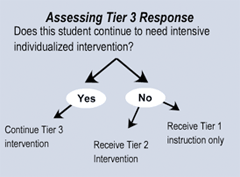How can Tier 3 intervention be implemented?
Page 6: Assessing Tier 3 Response

This flowchart figure summarizes the decision-making process for assessing Tier 3 Response. The flowchart is titled “Tier 3 Response.” The following question is asked below the title “Does this student continue to need intensive individualized intervention? There are two arrows coming off this question pointing to either Yes or No. Under the Yes is a small arrow pointing to the text “Continue Tier 3 intervention.” Under the No are two small arrows pointing to either “Receive Tier 2 Intervention” or “Receive Tier 1 instruction only.”
In Tier 3, teachers monitor students’ progress to determine how they are responding to intervention. With these data, teachers can determine the instructional needs of a student and the tier at which the student should receive this level of instruction. Tier placement options include:
- Continuing Tier 3 intervention
- Discontinuing Tier 3 intervention and receiving Tier 2 intervention to support the eventual transition to Tier 1 instruction only
- Discontinuing Tier 3 intervention and receiving Tier 1 instruction only
An IEP meeting must be held to change or discontinue Tier 3 special education services. During the meeting, the IEP team examines all of the available information and decides whether the student continues to need special education support. If the student continues to need special education support, the team reviews the IEP to ensure that it reflects the student’s current needs.

If the team decides that the student no longer requires special education services, the team is required to follow the procedures established by its state department of education for exiting him or her from special education. These procedures include a decision by the IEP team concerning appropriate placement and, ideally, a plan for transitioning the student to general education.
At Rosa Parks, the IEP team meets one year after Laney initially qualified for special education services for an annual review. The team will evaluate Laney’s progress, determine whether Laney met her goals, and ascertain her continuing need for special education services. They review Laney’s progress monitoring data and the results of an evaluation they requested. The team consists of:
 Mr. Brewster (classroom teacher)
Mr. Brewster (classroom teacher)- Ms. Jacobs (special education teacher)
- Mr. Johnson (school psychologist)
- Mrs. Jung (principal)
- Ms. Sanchez (speech pathologist)
- Mr. and Mrs. Gardner (Laney’s parents)
Basing its decision on the accumulated data, the team determines that Laney is performing at grade level and is confident that she can succeed with the supports available at Tier 2. The IEP team decides to continue special education services for Laney but to change her tier placement to Tier 2. Ms. Jacobs will continue to monitor Laney’s progress and will consult with Mrs. Washington, the reading specialist who provides Tier 2 intervention. If Laney demonstrates adequate progress toward grade-level goals with Tier 2 intervention, the IEP team will meet to discuss whether to exit Laney from special education.
For Your Information
It is critical to continue monitoring the progress of a student after he or she discontinues an intervention. In this way, a teacher can quickly catch a student who is beginning to fall behind, and a decision can be made about providing additional support for the student.